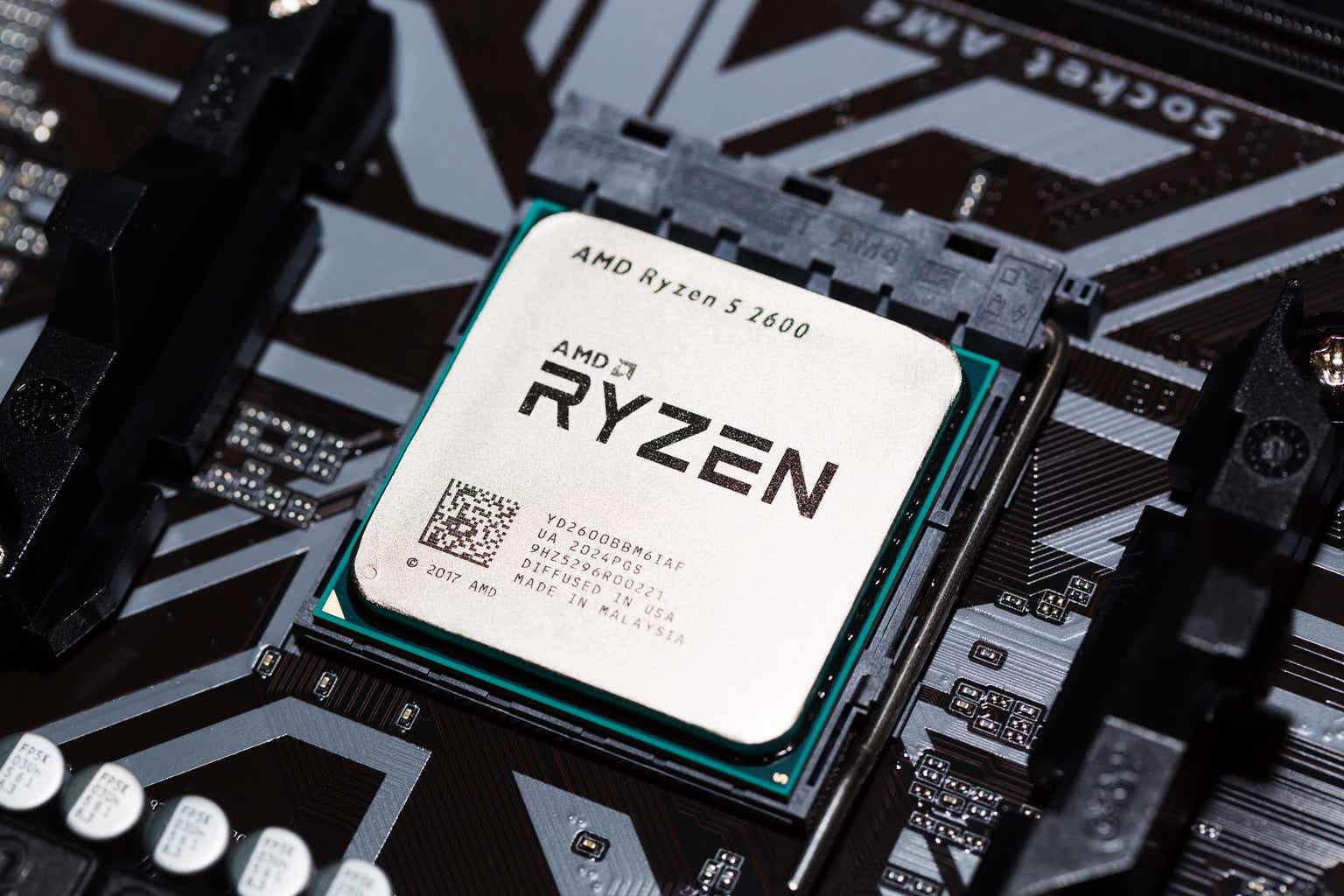AMD: The Bear Market Rally Is Over
nantonov
The sharp rebound of Advanced Micro Devices, Inc. (NASDAQ:AMD) over the recent months came to a sudden halt after market participants were once again surprised by the deteriorating outlook for the company.
Prompted by the bear market rally in equities, AMD's stock has almost doubled in a matter of just a couple of months from October of last year to March 2023. While everyone was cheering the new wave of AI-driven demand, the quarterly report from earlier this week is a warning that should not be ignored.
Seeking Alpha
As a result, the company is now underperforming the broader semiconductor sector as measured by the iShares Semiconductor ETF (SOXX). The reason why this is so important is twofold:
Firstly, AMD's share price is far more risky than the broader sector ETF as one could easily observe by the extreme volatility of the former in the graph below.
Secondly, during the past few years, AMD saw an unprecedented demand for its products across its entire portfolio.
Data by YCharts
After considering these two points, AMD has been a very poor investment even though it delivered a total return of nearly 50% since July of 2020 (the date I first covered the company).
The nearly 50% return is still above that of the S&P 500 for the period, however, once we take into account AMD's beta of almost 2.0 then it still underperformed the market on a risk-adjusted basis.
As a high beta company, AMD also benefited massively from the bear market rally in the equity market over the past few months. And as we are now facing the reality of a pending recession, things could get ugly.
To top all that, Wall Street Analysts have also turned extremely bullish on the company in recent months, thus prompting a sharp recovery since the second half of 2022.
Seeking Alpha
With so much optimism being baked into the share price, a lot of market participants might be wondering why AMD's share price reacted so violently on the recent results. To some, a 9% daily drop could even sound as if the market has lost its mind on this AI-powerhouse.
The Not So Surprising Worsening Outlook
As a starting point, investors should stop looking at AMD as a $150 stock, just because it reached these levels back in 2021. As I previously explained, the stock was caught by the recent wave of liquidity in the markets and thus reached unsustainable levels.
But as liquidity is slowly normalizing, investors should now prioritize actual business performance, while also taking into account all the risks associated with the business cycle.
The outlook provided earlier this week was a clear indication that there are problems ahead. Segments that are more heavily exposed to fluctuations in consumer spending are usually the first to take a hit and with that the client and gaming business units are already under severe pressure.
AMD Investor Presentation
That is also why, these two business units were now simply taken out of AMD's revenue outlook for the rest of 2023.
AMD Investor Presentation Q1 2023
Just a year ago, during Q1 2022 results, AMD's revenue guidance was including all segments and gross profitability was expected to be way higher.
AMD Investor Presentation Q1 2022
Even when it comes to operating expenses, AMD is now guiding for "Flattish quarterly until the demand environment improves", but as revenues fall, "flattish" operating expenses still mean much lower profitability even if we disregard the falling gross margin.
This once again leads us to one of the key issues for AMD - its profitability.
Cyclical Profitability
When compared to the 2021 highs, AMD's operating profitability is already below its highs across most of its segments. The highest margin Client segment is already close to being loss making, even though we are not in a recession yet.
prepared by the author, using data from SEC Filings
The inclusion of Xilinx in the past 12-month period has resulted in a massive increase of margins in the Embedded segment, but as we will see later, the deal is also associated with shareholder value destruction.
We should also mention that the large decrease in AMD's total operating margin over the past year has been due to the inclusion of a massive annual amortization charge following the Xilinx deal.
When it comes to amortization of intangible assets, most analysts are tempted to simply ignore these as they are non-cash items that come as a result of the current accounting standards. Be that as it may, this also means that the company acquiring these intangibles would need to increase its spending in the future in order to properly support and develop them.
In the case of AMD, these are almost equally split between developed technology and customer relationships, meaning sustainably higher research & development and marketing & sales expenditures going forward.
AMD 10-K SEC Filing
What we also observe from the table above is that the useful life of these assets is very high at 16 and 14 years respectively. In my view, these are too aggressive assumptions for a fast-moving sector such as semiconductors.
Even if we ignore these accounting issues, however, AMD Non-GAAP operating income took a massive hit during the first quarter of this year, falling by nearly 40%.
AMD Investor Presentation
In the graph below I am already using Non-GAAP operating margin for 2022 and 2023 periods and as we see, AMD's Price-to-Sales multiple is still too high based on its current operating margin.
prepared by the author, using data from SEC Filings and Seeking Alpha
Not to mention, the risk of further deterioration of AMD's margins through the rest of the year which could bring yet another sharp downward repricing of the company's sales multiple.
As strong as demand in the Data Center segment is, it would hardly be sufficient to make up for the loss of income within the Client and Gaming segments.
That is why, the main hope of management is that the current downturn will be very brief which would allow AMD to turn to GAAP profitability once again in 2023.
AMD Investor Presentation
But the risk that this might not be the case is too high at this point and in such a scenario, AMD's low profitability will once again be a major disadvantage in a highly competitive segment of the semiconductors industry.
Shareholder Value Destruction
Lastly, I would like to touch upon an issue that seems to be getting lost among all the hype of AI-driven demand.
Inexperienced investors are usually very cheerful when a large and exciting M&A transaction happens since their beloved company would now solidify its positioning and even expand into new product areas.
As always, the issue is how much is the company paying for this opportunity and is the price tag justified for the benefits that could be expected. On top of that is the question mark of the company's long-term competitiveness within the new field.
The recent Xilinx acquisition was indeed highly complementary for AMD's existing businesses, but it was also associated with enormous shareholder dilution.
prepared by the author, using data from SEC Filings
The deal was initially announced in October of 2020 with a price tag of $35bn, but the rise of AMD share price has resulted in this price tag ballooning to nearly $50bn as of February of 2022.
Xilinx Acquisition On February 14, 2022, the Company completed the acquisition of all issued and outstanding shares of Xilinx, a leading provider of adaptive computing solutions, for a total purchase consideration of $48.8 billion ($46.4 billion, net of cash acquired of $2.4 billion). (...) As the transaction closed prior to the opening of markets on the Xilinx Acquisition Date, the fair value of the common stock issued to Xilinx stockholders was based on the closing price of the Company's common stock on February 11, 2022 of $113.18 per share. Source: AMD 10-K SEC Filing
This price tag now represents nearly a third of AMD's market capitalization of $145bn, but the sales attributable to Xilinx are roughly a fifth of AMD's total revenue figure.
AMD 10-K SEC Filing
In terms of operating income, the deal was highly accretive to AMD but as the worsening outlook weighs on the whole sector it might not be long before more issues begin to emerge.
Conclusion
Even though the narrative around AMD is still very strong, the shareholders are now faced with a very high risk of continuing to underperform both the equity market and the semiconductors sector more broadly. As I have outlined before, this could happen even if AMD continues to execute on its impressive product roadmap.
On the other hand, the risk of a more severe downturn in demand is real and AMD's low GAAP profitability is an issue. Last but not least, what used to work well over the past decade would not necessarily be the winning strategy for the next 10-year period. That is why I have recently taken a deep dive into the semiconductors industry for my subscribers for The Roundabout Investor and have short-listed the best-positioned names within the sector.
Source: Seeking Alpha


